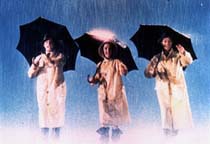 Musical
Musical
 Musical
Musical
The film genre most closely tied to the rising and falling fortunes of the Hollywood studio system was the musical. More than any other kind of film, the musical needed the lofty standards, the factory-manufactured glitz, and the tightly knit creative collaboration that characterized the "Golden Age" of Hollywood. The inherently unrealistic premise of song and dance within a dramatic narrative was perfectly complemented by the artificiality of the studio set. The genre's appeal dissolved, along with the power of the studio system, in the mid-1950s.
It was with The Jazz Singer (1927) that the musical made its first, attention-grabbing performance.. In retrospect, it was not so much the film as the brash, exuberant personality of its star, Broadway mainstay Al Jolson, that set the mood of the genre and inspired remakes in 1953 and 1980. And it was Jolson's follow-up film, The Singing Fool (1928), that really launched the musical craze, playing as the debut film in many theaters recently converted to sound. Hollywood lost no time in signing other "hot" Broadway performers like Fanny Brice, Sophie Tucker, George Jessel, and Marilyn Miller, only to encounter a cool reception from the ticket-buying public. It was MGM's box-office sensation and Oscar-winning Broadway Melody (1929), the first in a succession of "backstage" musicals (1935, 1937, 1940), together with musical revue films like Hollywood Revue (1929), that established the narrative conventions of the musical. Once established, the studios began cranking out product with the regularity of an assembly line.
It would take a director and a dancer from Broadway to transform the genre into a vibrant film form. Busby Berkeley arrived in Hollywood to direct the musical sequences for Eddie Cantor's Whoopee! (1930) and Palmy Days (1931) and gave a brief preview of his extravagant technique and neo-surrealist style. With Gold Diggers of 1933 (1933), 42nd Street (1933), and Footlight Parade (1933), Berkeley's style synthesized into an ecstatic fragmentation of space, time, and movement, with a bustling camera slithering underneath glass floors and around the heads and between the legs of chorus girls.
In the films of Fred Astaire the camera was no such frenetic voyeur; here the screen was transformed into a sparkling arena for the celebration of sleek, discerning movement, as Astaire and Ginger Rogers performed stylized mating rituals amid the gleaming silver-white sets of their RKO musicals The Gay Divorcee (1934), Top Hat (1935), and Swing Time (1936). With Berkeley and Astaire the genre was reborn and redefined. Each Hollywood studio strove to achieve a balanced mixture of stylized movement and artificial grandeur with its own stars and filmmakers—whether it was Fox's innocently bouyant Shirley Temple musicals (Bright Eyes, 1934; Curly Top, 1935); the same studio's eye-melting Technicolor Betty Grable spectacles (Coney Island, 1943; Mother Wore Tights, 1947); Goldwyn's slapstick burlesques with Eddie Cantor (Roman Scandals, 1933) or Danny Kaye (Up in Arms, 1944 or The Kid from Brooklyn, 1946); or Columbia's Grace Moore urban operettas (One Night of Love, 1934; Love Me Forever, 1935) and lush Rita Hayworth post-war valentines (Cover Girl, 1944; Down to Earth, 1947).
It was the Arthur Freed unit at MGM, however, that assimilated the various conventions of the genre into a series of musical classics, from the narrative innovations of Meet Me in St. Louis (1944) to the lush studio finery of The Pirate (1948) to the cartoon realism of On the Town (1949). With its meticulous standards and unmatched in-house creative team (Astaire, Gene Kelly, Judy Garland, Vincente Minnelli, Roger Edens, Betty Comden and Adolph Green, Robert Alton, Stanley Donen), MGM pushed the musical film to its peak. Kelly and Donen's Singin' in the Rain (1952) blended a backstage narrative with elements of revue, slapstick, and dance to create a magnificent, unpretentious tour de force.
By the mid-fifties the genre, along with the studio system, was in decline. With continuously mounting expenses and the surging popularity of television, the musical's luminously manufactured artificiality was turning into an impossible dream. Expensive Broadway adaptations (The Sound of Music, 1965; My Fair Lady, 1964) became sink-or-swim gambles for the major studios, with originality left to Walt Disney's Mary Poppins (1964) and the early Elvis Presley vehicles (Love Me Tender, 1956: Jailhouse Rock 1957). Rock music promised some hope (A Hard Day's Night, 1964: Saturday Night Fever, 1977). Aside from the achievements of Bob Fosse (Cabaret, 1972; All That Jazz, 1979), recent attempts at reviving the form have enjoyed little success at the box office (New York, New York, 1977). The most successful musical films of the last few decades have been have been documenatries of documentaries of performers on tour or at importand concerts (Woodstock, 1970; One Plus One, 1970; The Last Waltz, 1978; Stop Making Sense, 1984). Finally, the Disney Studio has produced a series of very well-receivedanimated musicalw which have appealed to both children and adults(Beauty and the Beast, 1991; Aladdin, 1992: The Lion King, 1994